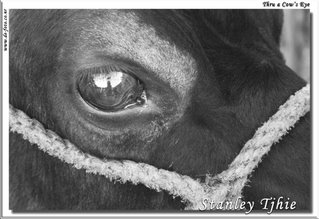
Milking is the act of removing milk from the mammary glands of an animal, typically cows (cattle) and goats. A rarely used term for the milking of cows is vaccimulgence, derived from the Latin words vacca ("cow") and emulgere ("to milk out"). Milking is also used to describe the removal of venom from spiders and snakes, for the production of antivenom.
Cows can be milked by hand or by machine.
Hand milking is performed by massaging and pulling down on the teats of the cow's udder, squirting the milk into a bucket.
(courtesy wikipedia.com)
The four streams of milk from the teatcups are usually combined in the claw and transported to the milkline or collection bucket (usually sized to the output of one cow) in a single milk hose. Milk is then transported (manually in buckets) or with a mechanical pump to a central storage vat or bulk tank. Milk is refrigerated on the farm in most countries either by passing through a heat-exchanger or in the bulk tank.
Milking machines keep the milk enclosed and safe from external contamination. The interior 'milk contact' surfaces of the machine are kept clean by a manual or automated washing procedure implemented after milking is completed. Milk contact surfaces must comply with regulations requiring food grade materials (typically stainless steel and special plastics and rubber compounds) and are easily cleaned.
Most milking machines are powered by electricity but, in case of electrical failure, there can be an alternative means of motive power, often an internal combustion engine, for the vacuum and milk pumps. Milk cows cannot tolerate delays in scheduled milking without serious milk production reductions.
(courtesy wikipedia.com)



2 comments:
Interesting photo. It's sort of haunting in a way.
Thanks for sharing.
Suzanne Lieurance
The Working Writer's Coach
http://www.workingwriterscoach.com
To suzannelieu,
haha. thank you. maybe we can see its fear of going to be slaughtered when it gets older
Post a Comment